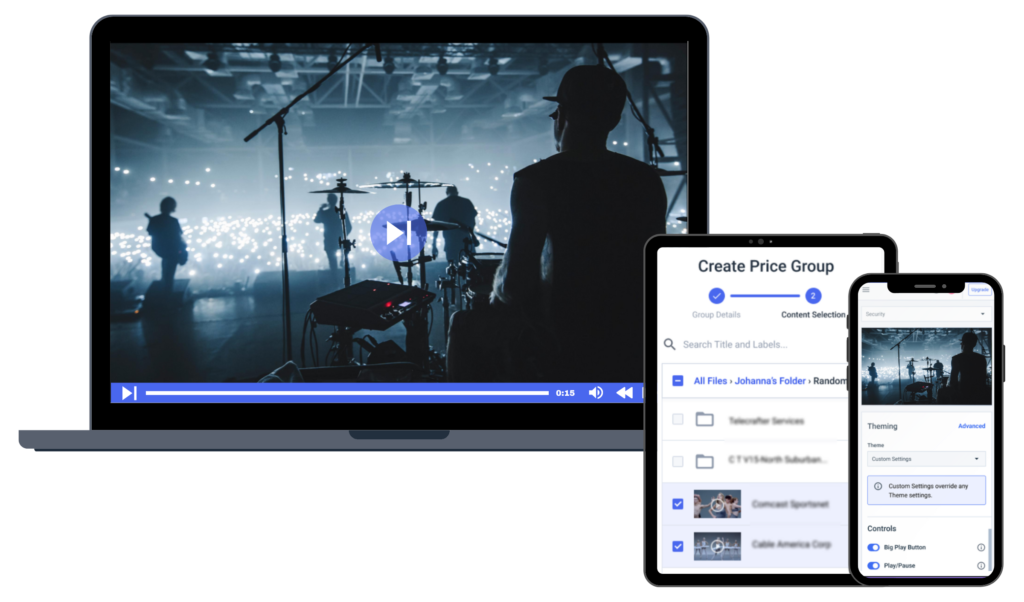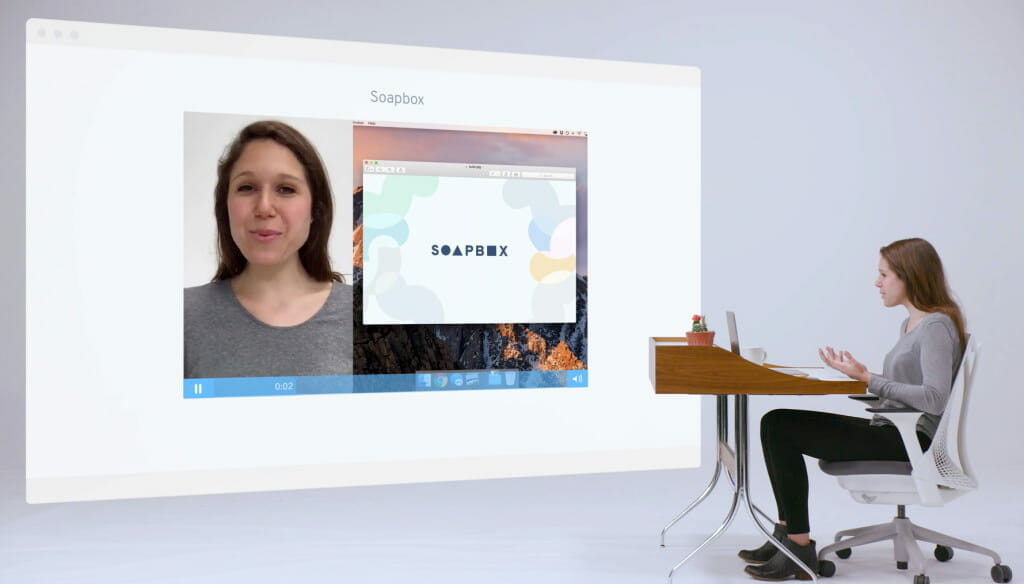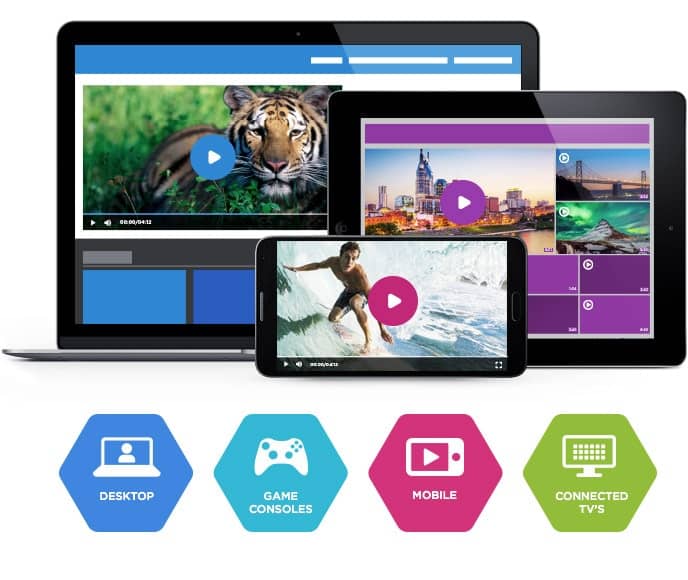Choosing an OTT Tool for Enterprise Video Content Management
Thanks to the internet, the modern media industry is exploding. People are watching more videos than ever before. Traditional broadcast TV is declining. And smartphones, connected TV, and browser-based viewing are booming.
To serve this need, businesses are increasingly investing in online video. And to deliver that video, OTT businesses need rock-solid enterprise video content management solutions. For example, businesses like hardware stores are increasingly posting how-to videos on their website to drive traffic and sales.
This post will look at the key features of professional video solutions. Plus, we’ll provide some recommendations for specific online video platforms. Let’s jump right in.
Table of Contents
What Is Enterprise Video Content Management?
The Growing OTT Video Market
Professional Video Hosting Platform Features
Enterprise Video Content Management
Dependable Security Measures
Robust Video Monetization
API Integration
The Best OTT Video Platforms
Conclusion
FAQ
What Is Enterprise Video Content Management?
By 2029, it’s projected that the number of users in the OTT video market will reach 4.9 billion, with an anticipated annual growth rate (CAGR 2024-2029) of 6.30%. This translates to a projected market volume of $429 billion by 2029.
This explosive growth is eroding the definitions of mass media. Some industry leaders are advocating that we stop differentiating between OTT and broadcast TV entirely. In the near future, all TV will be OTT.
This isn’t just true in the OTT industry, however. Online video is expanding across all industries. In a business setting, the most common uses of live streaming video are internal meetings, conference keynotes, and internal updates or announcements. Other common business uses for video include:
Sports
Education
eLearning
Legal compliance
Religious services
And much more
This blog is focused on professional, business users of online video. While OTT makes up one of the most important segments here, it’s not the only one. In total, the enterprise video platform market, valued at $17.36 billion in 2022, is expected to grow at a CAGR of 13.8% from 2022 to 2030. Experts predict it will reach $48.85 billion by 2030.
The Growing OTT Video Market

By 2024, it’s predicted that 310 million households will subscribe to at least one OTT service. In many countries, the annual growth rate for the OTT market is more than 30 percent.
This explosive growth is eroding the definitions of mass media. Some industry leaders are advocating that we stop differentiating between OTT and broadcast TV entirely. In the near future, all TV will be OTT.
This isn’t just true in the OTT industry, however. Online video is expanding across all industries. In a business setting, the most common uses of live streaming video are internal meetings, conference keynotes, and internal updates or announcements. Other common business uses for video include:
- Sports
- Education
- eLearning
- Legal compliance
- Religious services
- And much more
This blog is focused on professional, business users of online video. While OTT makes up one of the most important segments here, it’s not the only one. In total, the enterprise video platform market is expected to grow at an annual average rate of 18+% from 2018 to 2026. In addition, experts predict it will reach $915 million by 2026.
Professional Video Hosting Platform Features
At this point, we’ve covered some of the main statistics showing the growth of the OTT industry and business video in general. Let’s switch gears now. In this section of the article, we’ll look at some of the important features of enterprise CMS platforms.
These are some of the most critical features to consider and seek from an OVP. When you’re choosing a video live streaming platform for your business, you want to be sure it meets these basic OTT needs.
1. Enterprise Video Content Management
At this point, we’ve covered some of the main statistics showing the growth of the OTT industry and business video in general. Let’s switch gears now. In this section of the article, we’ll look at some of the important features of enterprise CMS platforms.
These are some of the most critical features to consider and seek from an OVP. When you’re choosing a video live streaming platform for your business, you want to be sure it meets these basic OTT needs.
1. Enterprise Video Content Management
A functional Enterprise video streaming CMS platform will provide a range of features. Among other features, these should include:
Ability to batch edit/delete videos
Support for adding a custom thumbnail
Ability to group videos
Bulk upload capability
Embed a video anywhere
Replace a video without changing the URL or updating embed codes
The first requirement for OTT businesses is the ability to manage a large library of content. This means a professional-grade enterprise video content management platform.
You might think that all enterprise video platforms are easy to use. However, this is not generally the case. Many platforms aren’t optimized for libraries of thousands of pieces of content. You want to make sure your chosen platform can adapt with you as you expand from starting out to vast content backlogs.
Another feature to look for in this arena is the ability to have multiple simultaneous live streams. This is sometimes called “multi-channel live streaming.” Some platforms allow this functionality, while others do not. This can be a deal-breaker for OTT businesses.
2. Dependable Security Measures
As an OTT business, your profits rely on your content. That means you need to secure your content in a variety of ways.
The global impact of piracy is $71 billion a year, with the US economy losing around $30 billion to illegal streaming services and file sharing. Consequently, you want a video platform that includes a number of robust security offerings. These should include, at a minimum:
IP address (geographic) restrictions
AES encryption
Paywall protection with SSL encryption
HTTPS delivery
3. Robust Video Monetization
Security is great, but you also need direct video monetization tools to make an OTT business a success. There are three main ways to monetize online video: advertising, pay-per-view, and subscriptions.
Advertising is driving major revenue for various OTT businesses. However, subscriptions are extremely popular for their ad free experience. Some estimates are that more than a third of professional broadcasters monetize their content via subscription models. Pay-per-view is popular too, especially for one-time events like live sports.
One argument for PPV and subscription monetization is that ad-blockers block around 40 percent of ads online.
In short, look for a video platform that supports all three methods of monetization. This gives you the most flexibility in monetizing your content.
4. API Integration
An API, or Application Programming Interface, is another essential feature for OTT video. Most businesses, including OTT companies, are migrating to API-based workflows for online video.
A video API makes it faster and easier to create custom video portals, mobile live streaming apps, and more.
According to Streaming Media, “The video workflow and distribution environment are incredibly complex, and the way to build a best-of-breed system or even just gain finer control over tasks—especially when delivering video at scale—is by API.
The Best OTT Video Platforms
There are a variety of online video platforms on the market today. Let’s take a brief look at a few of the top OTT platforms while considering the features we’ve discussed here.
1. Dacast

Dacast offers powerful enterprise-grade content management. It includes all the security features listed above, and more. Plus, it offers monetization via a paywall feature in the Event plan and above, starting at just $63/month.
As far as content delivery, Dacast uses top-tier CDN networks for streaming and VOD. Buffering remains one of the most common issues while streaming live video. That’s why choosing a platform that uses a top-tier CDN like Akamai is so important. With Dacast, you also get the option to use multi-CDN services as an add-on.
Dacast also offers advanced video-on-demand functionality as well as China video hosting via its advanced video hosting platform.
2. Wistia

The second platform we’ll look at is Wistia. Wistia was originally founded in 2008 and provides a wide range of VOD hosting tools for business. These include some of the best analytics and video marketing tools around.
More importantly, Wistia has evolved beyond just VOD hosting to offer live streaming capabilities on its Pro plan and the plans above it, starting from $99 per month. With the Wistia Live feature, you even get access to simple simulcast settings that allow you to live stream content or your event to social platforms like Facebook, LinkedIn, and X.
Advanced security features like single sign-on (SSO) are available on the highest tier Premium plan. While monetization isn’t directly built-in, integrations with tools like InPlayer allow for paywalling live broadcasts and on-demand videos.
3. Brightcove

The next platform in our comparison is Brightcove. Brightcove was originally launched in 2004, and is one of the largest online video streaming platforms. It provides several products and solutions tailored to different enterprise needs, with custom quotes available for specific requirements.
The Communications Studio is designed for marketers and corporate communications professionals, featuring live streaming, virtual events, and on-demand video content. The Marketing Studio caters to enterprise streaming solutions, boasting integrations with leading social media and marketing automation platforms, alongside advanced security features. There’s also a Media Studio for end-to-end OTT streaming video, with flexible monetization.
Brightcove’s enterprise video content management capabilities ensure content security and provide insightful analytics to inform marketing strategies.
4. Kaltura

Kaltura positions itself as a one-stop shop for all your enterprise video content management needs.
Founded in 2006 and built on open-source technology, Kaltura offers a wide range of streaming options for enterprises. Its OTT solution supports live and on-demand video streaming services, as well as robust content management capabilities.
Kaltura’s platform provides advanced security features, including access control, Digital Rights Management (DRM), and content tokenization. Monetization tools for subscriptions and advertising are also available.
Additionally, businesses can leverage Kaltura’s APIs for custom integrations and create a branded video portal or streaming app. It’s also possible to connect external recommendation engines. You must reach out to Kaltura, however, to get pricing information.
5. IBM Video Streaming

For businesses demanding top-tier security and scalability, IBM Video Streaming is a compelling option.
IBM Video Streaming is a powerful OTT solution designed for businesses that demand high-quality video streaming services. The platform leverages IBM Cloud infrastructure to offer unparalleled data security and reliability.
Granular permissioning ensures strict control over video access, while DRM safeguards sensitive content. Even its base Enterprise video streaming plan, starting at $799, offers SSO. IBM Video Streaming integrates with popular marketing automation tools and supports various streaming options, including live and VOD. The platform also supports simultaneous streams, making it suitable for large-scale live events and corporate communications.
The platform scales seamlessly to accommodate growing video libraries and high volumes of concurrent streams, making it ideal for large enterprises.
FAQ
1. What is the enterprise content management strategy?
An enterprise content management (ECM) strategy is a comprehensive plan that outlines how an organization will create, manage, store, distribute, and archive digital content throughout its lifecycle.
The strategy typically involves defining policies, processes, and technologies to ensure efficient and secure content management across the enterprise.
2. What is meant by API?
API stands for Application Programming Interface. It is a set of rules, protocols, and tools that specify how software applications should communicate with each other.
In the context of enterprise video content management, APIs enable the platform to integrate with other systems, such as content management systems, marketing automation tools, or custom applications.
3. Is VOD streaming free?
Video on Demand (VOD) streaming can be both free and paid. It just depends on the platform and the content provider’s business model. Common models include free but ad-supported, subscription-based, pay-per-view, and freemium.
4. How do enterprises use content management systems?
Enterprises use content management systems (CMS) to centralize and streamline the creation, management, and distribution of digital content across the organization. This content includes documents, media files (including video), web content, and other digital assets.
With CMS platforms, enterprises can handle such content with features like content authoring tools, workflow management, version control, access controls, and publishing capabilities.
5. Is enterprise content management the same as ERP?
No, ECM and enterprise resource planning (ERP) are not the same, although they can be complementary.
ECM focuses on managing all digital content, while ERP focuses on managing core business processes like accounting, finance, and supply chain. However, some advanced ECM systems can integrate with ERP for a more holistic information management experience.
Conclusion
The OTT video market is booming. To be part of that, you need a robust video streaming platform. OTT businesses need to organize, secure and monetize their content. Plus, they need to deliver their video via custom API solutions.
Hopefully, this blog has introduced you to some of the most important considerations for OTT video hosting. Any questions? Let us know in the comment section below! We love to hear from our readers and will respond as soon as we can. For regular tips on live streaming, as well as exclusive offers, we also invite you to join our LinkedIn group.
Not yet a Dacast client but interested to give our platform a try? You can take advantage of our 14-day free trial (no credit card required) by clicking the button below. This will allow you to test our professional features for yourself at no cost.
Thanks for reading, and good luck with your live streaming!
 Stream
Stream Connect
Connect Manage
Manage Measure
Measure Events
Events Business
Business Organizations
Organizations Entertainment and Media
Entertainment and Media API
API Tools
Tools Learning Center
Learning Center Support
Support Support Articles
Support Articles